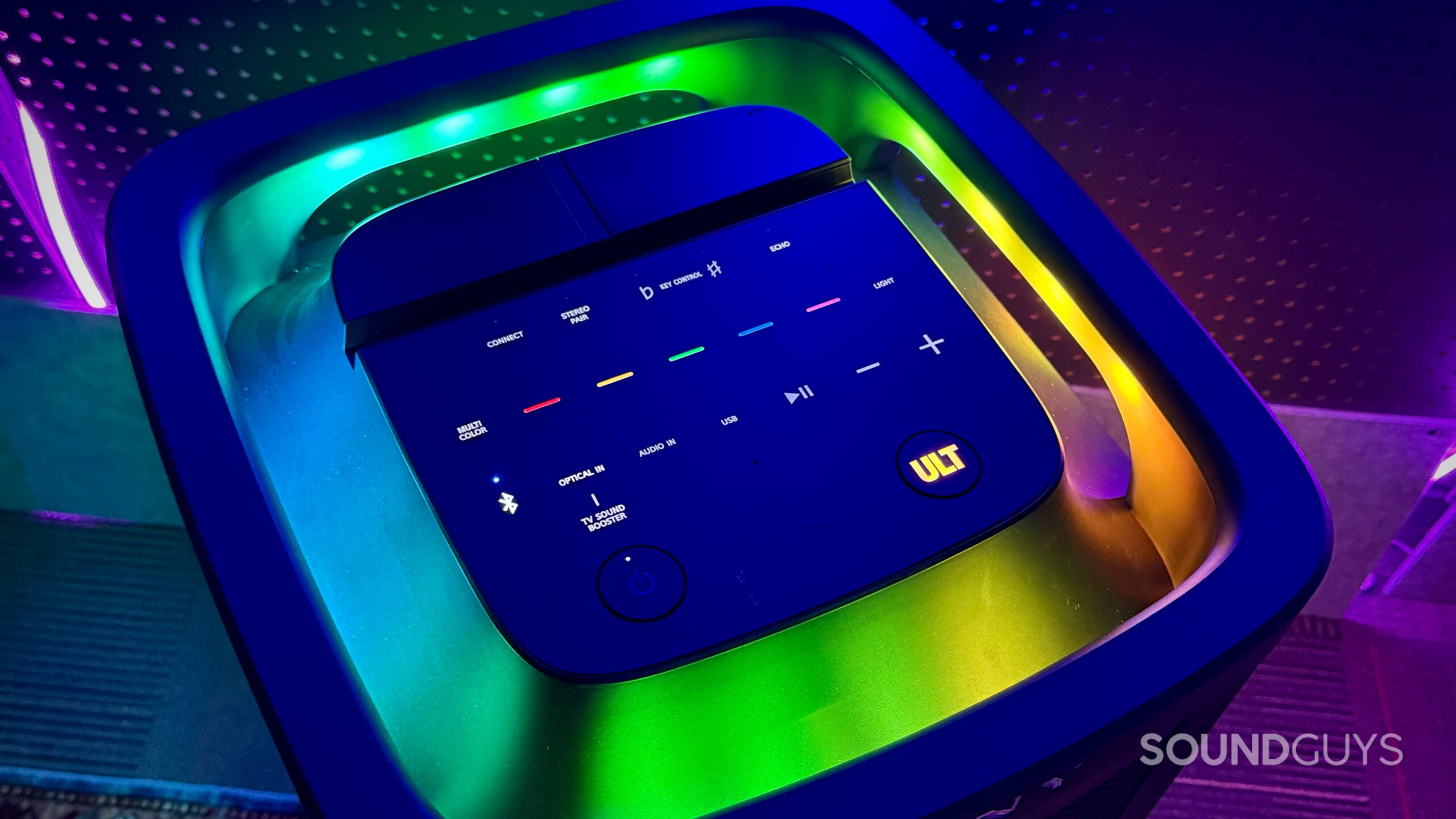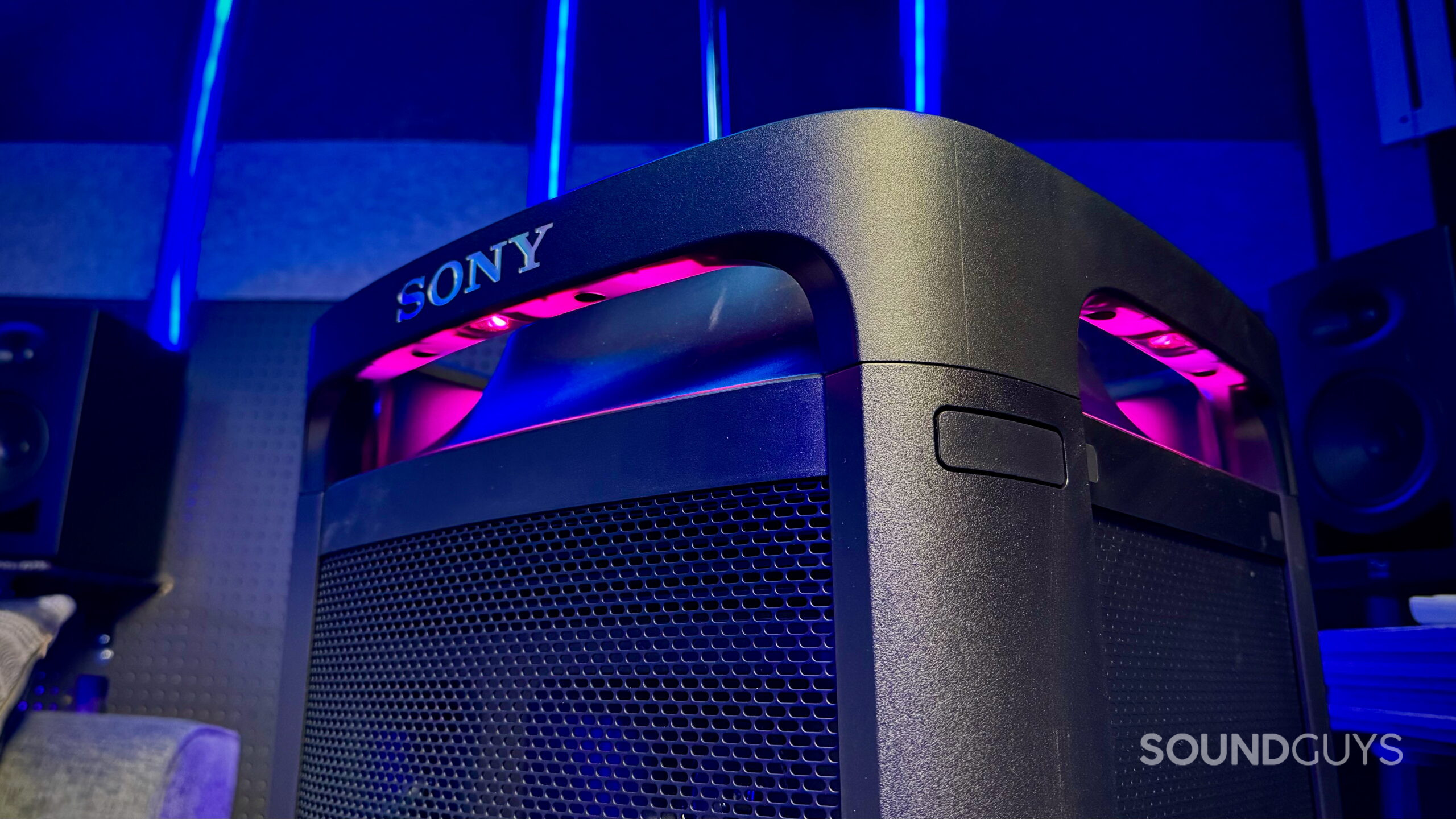All products featured are independently chosen by us. However, SoundGuys may receive a commission on orders placed through its retail links. See our ethics statement.

Sony ULT Tower 9 review: The king of party speakers?
Published onApril 18, 2025
Sony ULT Tower 9
Sony continues to expand its ULT lineup with the mammoth ULT Tower 9. This towering speaker checks all the party box essentials: Chest-thumping bass, built-in lights, and a few karaoke tricks up its sleeve. But is it the ultimate party starter? Let’s cue up some tracks and find out in this Sony ULT Tower 9 review.
This article was published on April 17th, 2025, and this is the first version of the article. Updates will follow as the market changes.
What I like about the Sony ULT Tower 9

The Sony ULT Tower 9 is an absolute beast. This aptly named unit stands roughly three feet tall and weighs around 62 pounds, so props to Sony for including built-in handles and even adding wheels to make it easier to move. For such a massive speaker, it’s surprisingly easy to tote around on flat surfaces, but maybe grab a friend if you plan on hoisting it onto a table. When you’re ready to party, the ULT Tower 9 connects via Bluetooth and AUX-in, but here’s something you don’t see on every party speaker—it also includes an Optical input for use with a TV, and Sony even throws in the cable.
Up top, you’ll find the control panel with a variety of well-lit touch controls. From here, you can manage playback, switch audio sources, customize your lighting effects, and fine-tune your karaoke experience. Just above the panel, tucked under a small flap, are two 1/4-inch inputs for a microphone or guitar. Sony naturally recommends its own ULT series wireless microphones, but any old microphone and XLR to 1/4″ cable will work.
Once it’s karaoke time and you’ve connected the wireless mic receiver, Sony gives you a few fun ways to tweak your favorite tracks. First up is “Key Control,” which lets you change the song’s pitch during playback. It’s not perfect—pushing the pitch too high starts to venture into Mickey Mouse territory—but shifting up or down by a semitone works fine for most songs without much noticeable change in playback quality.
You also get some built-in echo (which is actually delay and not reverb), which helps smooth out vocals and makes just about anyone sound a bit more polished, regardless of skill level. There’s also a “Guide Vocal” feature that attempts to suppress the original lead vocals so you can sing over the track. In my testing, though, it’s not nearly as effective as the AI Vocal Removal feature on the Soundcore Rave 3S, and the more you increase it, the worse your playback quality gets.
When it comes to sound quality, the ULT Tower 9 delivers serious volume and impactful low-end. Featuring 1x woofer, 4x tweeters, and 2x mid-range drivers, it’s powerful enough to feel the bass thump in your chest, and loud enough to risk hearing damage at full volume if you’re in a smaller room. No joke! We try not to use the term “room-filling power,” but if any speaker earns it, it’s the ULT Tower 9.
Switching through the different ULT modes, I started with some classics like “Sweet Dreams (Are Made of These)” by the Eurythmics. With ULT 1 engaged, the speaker delivered a steady, satisfying pulse. Sub-bass accents hit with convincing resonance, all while Annie Lennox’s vocals stay clear and present in the mix. It felt like a sweet spot, punchy without going overboard.

But if you’re after pure low-end, ULT 2 doesn’t hold back. This setting cranks the bass to another level, and at higher volumes, you can really feel it. That said, while the thump hits hard during tracks like “Let’s Groove” by Earth, Wind & Fire, it starts to dominate the mix and drown out some of the treble details when listening to more modern tunes. On synthwave tracks like “Sunset” by The Midnight, ULT 2 was too much; the lead guitar line in the intro nearly vanished under the overpowering bass.
In the end, I found myself turning to the built-in 10-band EQ to fine-tune the sound of the ULT Tower 9 to my liking. It let me dial in a happy medium between the two ULT modes: enough low-end to feel the groove without overpowering the mix, a slight bump to the mids to keep guitars and vocals forward, and just the right amount of treble to help with clarity. Don’t be afraid to experiment! There is room to tweak.
What I don’t like about the Sony ULT Tower 9

Aside from its weight and size, which I can’t really fault since that’s the trade-off for chest-thumping bass and ear-splitting volume, there’s not much to complain about with the ULT Tower 9.
It does advertise 360-degree sound; to be fair, there are two rear-facing tweeters. But in practice, standing behind the speaker doesn’t deliver the same experience as being in front. You’ll get a bit more coverage from the rear than with most party speakers, but it still sounds noticeably more muffled from that angle. That said, the sheer output and volume of the Tower 9 easily fills a large room, so unless you’re standing directly behind it, you’re in for an impressively loud and immersive experience.
The app also packs in a few too many gimmicky karaoke features, like a voice changer that makes you sound like a Munchkin from The Wizard of Oz, a cartoon mouse, or like you’re singing through an old radio. Honestly, who wants to hear someone singing like a Munchkin? Probably no one. Fun for a quick laugh, maybe, but more annoying than useful during an actual party. I would’ve much rather seen a more effective “Guide Vocal” feature that could better strip out lead vocals without degrading the overall playback quality.
Should you buy the Sony ULT Tower 9?

If you’re in the market for a massive, no-compromise party speaker with club-level output and the ability to turn any gathering into a full-blown karaoke session, the ULT Tower 9 brings the bass, lights, and features to get the party started and keep it going. You may find yourself switching between its two ULT modes depending on the genre or mood, but fortunately, the built-in 10-band EQ makes it easy to strike an ideal balance.
Alternatively, if you like the idea of a party speaker for your next get-together but the ULT Tower 9 is overkill, consider a smaller speaker like the JBL PartyBox Stage 320 ($599.95 at Amazon) or the more affordable Soundcore Rave 3S ($349.99 at Amazon).

Sony ULT Tower 9 review: FAQs
To pair the Sony ULT Tower 9 to your device, press the Bluetooth button once to enter pairing mode. Open Bluetooth settings on your device and select "ULT Tower 9."
No, the ULT Tower 9 does not feature an IP rating against the elements.
Yes, the ULT Tower 9 can connect to a second ULT Tower 9 for true stereo performance or other ULT speakers like the ULT Field 5 for additional mono playback.
There are two versions of the ULT Tower 9. The ULT Tower 9AC, which only runs off AC power, and the regular ULT Tower 9, which contains a battery. Sony states the latter can offer up to 25H of battery life.
Sony states up to 25H of playback from the ULT Tower 9 (non-AC version).
Yes! The ULT Tower 9 features an Optical connection for use with a TV.
Sold separately, you can purchase the Sony ULT Microphone kit to use with the ULT Tower 9.